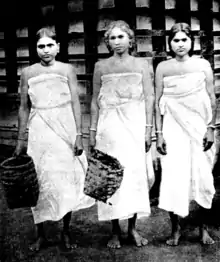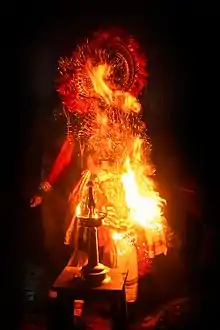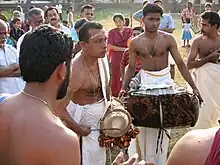Ambalavasi, more properly Ampalavasi, (IAST: Ampalavāsi; lit. 'temple-dwelling') is the generic name for a group of castes among Hindus in Kerala, India, who have traditionally rendered temple services.[1]
Castes

The Ambalavasis are broadly divided into two groups, being those who wear the sacred thread and those who do not.
Sacred thread wearers
Pushpaka Brahmins
Others
Threadless Ambalavasis
Temple services
Though all Ampalavāsis have to do service in temples, they have sufficiently distinct functions to perform. Pushpakans and Nambeesans are teachers in the Pathasalas or Mutts and suppliers of flowers to temple.[1] Chakyar stages dramas called Kooth and Koodiyattam.[4] Marars are temple musicians. Variar and Poduval did managerial and executive functions of temple committees and served as storekeepers and watchmen.[5]
Customs
Their ritual rank in Hinduism is lies between brahmin and nair.[6][7][8][9] Ambalavasis were known as antharala jathikal.
Kazhakams
Kazhakams or Ambalakkazhakams refer to associations of Ambalavasi peoples in a temple to perform specific duties in the temple.[10]
Temple arts



Sri. Chendamangalam Unnikrishna Maarar in action - In the middle.
Traditionally, Ambalavasis are associated with various types of temple arts. Earlier, each of these temple arts were performed only by specific Ambalavasi castes. Now there is no community or caste barrier.
| Temple Art | Associated Ambalavasi castes |
|---|---|
| Koodiyattam | Chakyar[11] |
| Kooth | Chakyar,[12] Nangyar (women of Nambiar)[13] |
| Certain roles of Krishnanattam | |
| Mizhavu (Musical Instrument) | Nambiar[14] |
| Thullal | |
| Pathakam | Nambiar[15] |
| Theeyattu | |
| Ilathalam (Musical instrument) | |
| Vadyams (Musical instruments) like Chenda, Thimila, Idakka, Udukku etc. | Marar[3] |
| Sopanasangeetham | |
| Panchavadyam | |
| Thayampaka | |
| Pandi Melam | |
| Panchari Melam | |
| Brahmanippattu | Brahmani (women of Nambeesan)[16][17] |
References
- 1 2 3 Fuller, Christopher J. (1976). The Nayars Today. Cambridge University Press. p. 13. ISBN 978-0-52129-091-3.
- 1 2 3 4 5 Gough, Kathleen (1961). "Nayars: Central Kerala". In Schneider, David Murray; Gough, Kathleen (eds.). Matrilineal Kinship. University of California Press. pp. 309–311. ISBN 978-0-520-02529-5.
- 1 2 Lalitha, Nandini (27 December 2018). "This instrument represents the sastras and vedas". The Hindu.
- ↑ Daugherty, Diane (Spring 1996). "The Nangyār: Female Ritual Specialist of Kerala". Asian Theatre Journal. 13 (1): 54–67. doi:10.2307/1124302. JSTOR 1124302.
- ↑ People of India - India's Communities N-Z. Oxford University Press. 1998. pp. 2861–2863.
- ↑ Census commissioner Cochin (India)., Achyuta menon B A (10 November 1893). "Report on the Census of Cochin, 1891 A.D. - 1066 M.E."
- ↑ Gundert, Hermann (1868). "Keralolpathi".
- ↑ Census report of cochin (1901).
{{cite news}}: Missing or empty|title=(help) - ↑ Pisharoti, Rama (1926). "Pisharoti rituals". The Journal of the Royal Anthropological Institute of Great Britain and Ireland. 56: 83–89. doi:10.2307/2843601. JSTOR 2843601.
- ↑ People of India - India's Communities N-Z. Oxford University Press. 1998. pp. 3605–3607.
- ↑ Narayanan, Mundoli (2006). "Over-Ritualization of Performance: Western Discourses on Kutiyattam". TDR. 50 (2): 136–153. doi:10.1162/dram.2006.50.2.136. JSTOR 4492680. S2CID 57567794.
- ↑ "Latest India News | Breaking News | World & Business News | Sports & Entertainment news". Expressbuzz.com. Retrieved 30 September 2013.
- ↑ "The 'Florance' of Nangiar Koothu". No. 10 September 2015. Mathurubhumi Daily. 10 September 2015. Retrieved 17 February 2019. Quote: Nangyarkoothu is a traditional artform performed by the women of the Ambalavasi Nambiar community of Kerala, called Nangyaramma. However, people from other castes also has been performing the artform since the second half of the 20th century.
- ↑ Dutta, Madhumita (2008). Let's Know Music and Musical Instruments of India. Star Publications. p. 16.
- ↑ "Padakam, the poor cousin of Chakyarkoothu - Times of India". The Times of India. Retrieved 16 January 2018.
- ↑ Nampoothiri, M.V. Vishnu (2012). Folklore: The Identity of Culture. Department of Information & Public Relations, Government of Kerala. p. 73.
- ↑ V.T., Induchudan (1969). The Secret Chamber: A Historical, Anthropological & Philosophical Study of the Kodungallur Temple. Cochin Devaswom Board. p. 260.